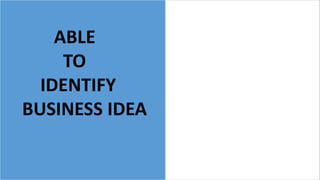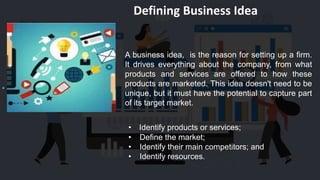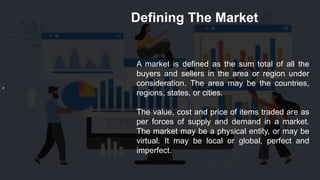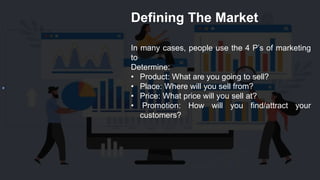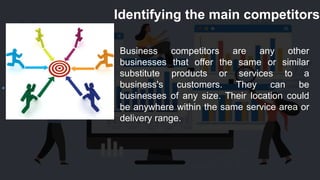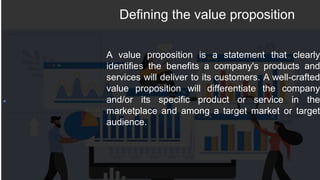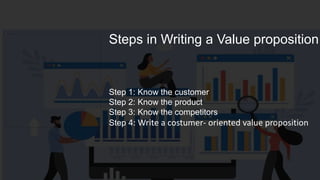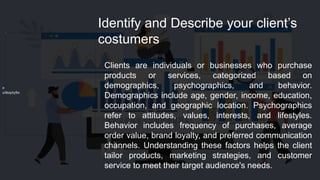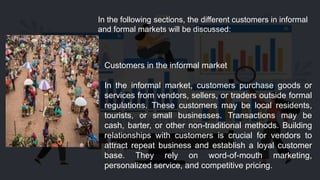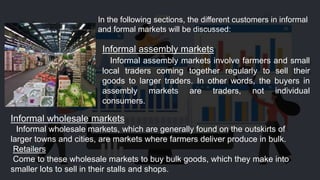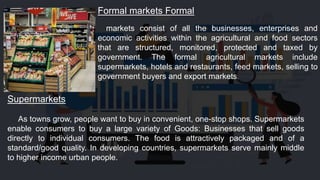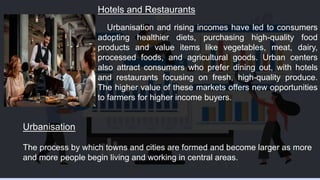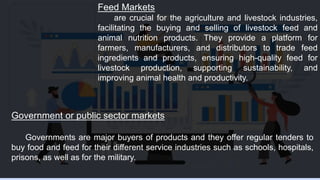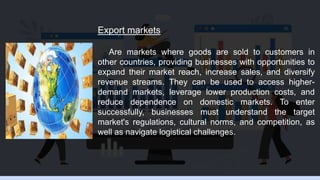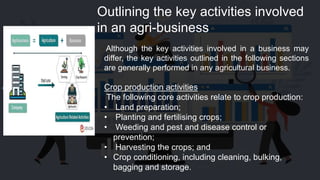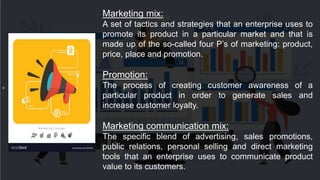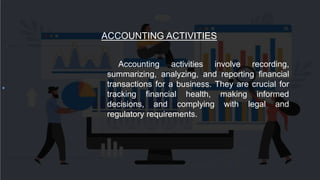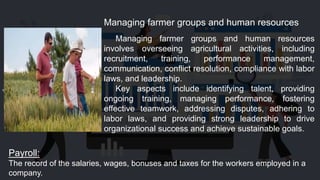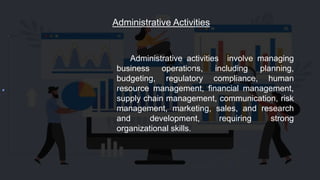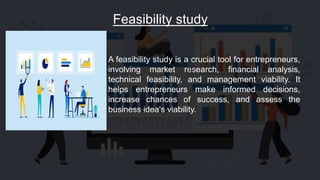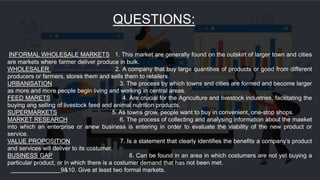ABLE TO IDENTIFY TO A BUSINESS IDEA
- 2. Defining Business Idea A business idea, is the reason for setting up a firm. It drives everything about the company, from what products and services are offered to how these products are marketed. This idea doesn't need to be unique, but it must have the potential to capture part of its target market. ÔÇó Identify products or services; ÔÇó Define the market; ÔÇó Identify their main competitors; and ÔÇó Identify resources.
- 3. Identifying a Product or Services Every business relies on a product that is sold to customers, and the business idea has to identify, and define that product clearly and accurately. A product is a tangible item that is put on the market for acquisition, attention, or consumption, while a service is an intangible item, which arises from the output of one or more individuals. Although it seems like the main distinction between the two concepts is founded on their tangibility, that is not always the case. In most cases services are intangible, but products are not always tangible.
- 4. Identifying a Product or Services Every business relies on a product that is sold to customers, and the business idea has to identify, and define that product clearly and accurately: Products are simply objects that are manufactured, stored, transported, advertised, and then sold. While products can either be tangible or intangible, services are intangible. The differences between products and services are based on different factors, including tangibility, perishability, variability, and heterogeneity.
- 5. Defining The Market A market is defined as the sum total of all the buyers and sellers in the area or region under consideration. The area may be the countries, regions, states, or cities. The value, cost and price of items traded are as per forces of supply and demand in a market. The market may be a physical entity, or may be virtual. It may be local or global, perfect and imperfect.
- 6. Defining The Market In many cases, people use the 4 PÔÇÖs of marketing to Determine: ÔÇó Product: What are you going to sell? ÔÇó Place: Where will you sell from? ÔÇó Price: What price will you sell at? ÔÇó Promotion: How will you find/attract your customers?
- 7. Identifying the main competitors Business competitors are any other businesses that offer the same or similar substitute products or services to a business's customers. They can be businesses of any size. Their location could be anywhere within the same service area or delivery range.
- 8. Identifying the resources In order to create value, businesses must combine these resources in an efficient way. The most successful businesses are those that can create the most value with the fewest resources. In business, a resource is anything that can be used to produce value. This includes both physical resources like land, raw materials, and equipment, as well as human resources like the labor force and knowledge base.
- 9. Identifying The Business Gap s A business gap can be found in an area in which consumers are not yet buying a particular product, or in which there is a customer demand that has not been met. However, for many business ideas, the gap is quite small and there may be many people offering similar products. Business gaps range from the need for similar products that are better quality, or lower price, to new products and to changing a current product, or offering it in an alternative way, e.g. importing bulked soybean or providing organic coffee to the international market.
- 10. Defining the value proposition A value proposition is a statement that clearly identifies the benefits a company's products and services will deliver to its customers. A well-crafted value proposition will differentiate the company and/or its specific product or service in the marketplace and among a target market or target audience.
- 11. Steps in Writing a Value proposition Step 1: Know the customer Step 2: Know the product Step 3: Know the competitors Step 4: Write a costumer- oriented value proposition
- 12. uilkopty9o Identify and Describe your clientÔÇÖs costumers Clients are individuals or businesses who purchase products or services, categorized based on demographics, psychographics, and behavior. Demographics include age, gender, income, education, occupation, and geographic location. Psychographics refer to attitudes, values, interests, and lifestyles. Behavior includes frequency of purchases, average order value, brand loyalty, and preferred communication channels. Understanding these factors helps the client tailor products, marketing strategies, and customer service to meet their target audience's needs.
- 13. In the following sections, the different customers in informal and formal markets will be discussed: Customers in the informal market In the informal market, customers purchase goods or services from vendors, sellers, or traders outside formal regulations. These customers may be local residents, tourists, or small businesses. Transactions may be cash, barter, or other non-traditional methods. Building relationships with customers is crucial for vendors to attract repeat business and establish a loyal customer base. They rely on word-of-mouth marketing, personalized service, and competitive pricing.
- 14. In the following sections, the different customers in informal and formal markets will be discussed: Informal assembly markets Informal assembly markets involve farmers and small local traders coming together regularly to sell their goods to larger traders. In other words, the buyers in assembly markets are traders, not individual consumers. Informal wholesale markets Informal wholesale markets, which are generally found on the outskirts of larger towns and cities, are markets where farmers deliver produce in bulk. Retailers Come to these wholesale markets to buy bulk goods, which they make into smaller lots to sell in their stalls and shops.
- 15. In the following sections, the different customers in informal and formal markets will be discussed: Informal retail customers Informal retail customers are consumers and small businesses (such as restaurants and street-food vendors), who buy their daily or weekly supplies of food. Wholesalers may try to prevent farmers from selling directly to retailers. Wholesaler: A company that buys large quantities of products or goods from different producers or farmers, stores them and sells them to retailers.
- 16. Formal markets Formal markets consist of all the businesses, enterprises and economic activities within the agricultural and food sectors that are structured, monitored, protected and taxed by government. The formal agricultural markets include supermarkets, hotels and restaurants, feed markets, selling to government buyers and export markets. Supermarkets As towns grow, people want to buy in convenient, one-stop shops. Supermarkets enable consumers to buy a large variety of Goods: Businesses that sell goods directly to individual consumers. The food is attractively packaged and of a standard/good quality. In developing countries, supermarkets serve mainly middle to higher income urban people.
- 17. Hotels and Restaurants Urbanisation and rising incomes have led to consumers adopting healthier diets, purchasing high-quality food products and value items like vegetables, meat, dairy, processed foods, and agricultural goods. Urban centers also attract consumers who prefer dining out, with hotels and restaurants focusing on fresh, high-quality produce. The higher value of these markets offers new opportunities to farmers for higher income buyers. Urbanisation The process by which towns and cities are formed and become larger as more and more people begin living and working in central areas.
- 18. Feed Markets are crucial for the agriculture and livestock industries, facilitating the buying and selling of livestock feed and animal nutrition products. They provide a platform for farmers, manufacturers, and distributors to trade feed ingredients and products, ensuring high-quality feed for livestock production, supporting sustainability, and improving animal health and productivity. Government or public sector markets Governments are major buyers of products and they offer regular tenders to buy food and feed for their different service industries such as schools, hospitals, prisons, as well as for the military.
- 19. Export markets Are markets where goods are sold to customers in other countries, providing businesses with opportunities to expand their market reach, increase sales, and diversify revenue streams. They can be used to access higher- demand markets, leverage lower production costs, and reduce dependence on domestic markets. To enter successfully, businesses must understand the target market's regulations, cultural norms, and competition, as well as navigate logistical challenges.
- 20. Although the key activities involved in a business may differ, the key activities outlined in the following sections are generally performed in any agricultural business. Crop production activities The following core activities relate to crop production: ÔÇó Land preparation; ÔÇó Planting and fertilising crops; ÔÇó Weeding and pest and disease control or prevention; ÔÇó Harvesting the crops; and ÔÇó Crop conditioning, including cleaning, bulking, bagging and storage. Outlining the key activities involved in an agri-business
- 21. Marketing and sales are distinct functions in a business. Marketing involves promoting and selling products or services through market research, advertising, branding, and customer engagement. Sales, on the other hand, converts leads into customers by closing deals and generating revenue. Marketing and sales involve the following key activities: ÔÇó Managing the marketing mix: product, price, distribution and promotion; ÔÇó Managing the marketing communication mix: advertising, sales promotions, public relations (PR) and direct selling (personal selling); ÔÇó Writing advertisements and press releases; and ÔÇó Selling the product to target markets.
- 22. Marketing mix: A set of tactics and strategies that an enterprise uses to promote its product in a particular market and that is made up of the so-called four PÔÇÖs of marketing: product, price, place and promotion. Promotion: The process of creating customer awareness of a particular product in order to generate sales and increase customer loyalty. Marketing communication mix: The specific blend of advertising, sales promotions, public relations, personal selling and direct marketing tools that an enterprise uses to communicate product value to its customers.
- 23. ACCOUNTING ACTIVITIES Accounting activities involve recording, summarizing, analyzing, and reporting financial transactions for a business. They are crucial for tracking financial health, making informed decisions, and complying with legal and regulatory requirements.
- 24. Managing farmer groups and human resources involves overseeing agricultural activities, including recruitment, training, performance management, communication, conflict resolution, compliance with labor laws, and leadership. Key aspects include identifying talent, providing ongoing training, managing performance, fostering effective teamwork, addressing disputes, adhering to labor laws, and providing strong leadership to drive organizational success and achieve sustainable goals. Managing farmer groups and human resources Payroll: The record of the salaries, wages, bonuses and taxes for the workers employed in a company.
- 25. Administrative Activities Administrative activities involve managing business operations, including planning, budgeting, regulatory compliance, human resource management, financial management, supply chain management, communication, risk management, marketing, sales, and research and development, requiring strong organizational skills.
- 26. Testing the viability of the business idea Testing the viability of a business idea involves evaluating its potential to succeed and meet criteria of a viable business. It involves assessing market demand, profitability, operational feasibility, and long-term sustainability. The main purpose is to determine if the idea is worth pursuing and investing resources into. One way of determining the viability of a new business is by using the results and findings of market research. Market research: The process of collecting and analysing information about the market into which an enterprise or a new business is entering in order to evaluate the viability of the new product or service.
- 27. Feasibility study A feasibility study is a crucial tool for entrepreneurs, involving market research, financial analysis, technical feasibility, and management viability. It helps entrepreneurs make informed decisions, increase chances of success, and assess the business idea's viability.
- 28. QUESTIONS: INFORMAL WHOLESALE MARKETS 1. This market are generally found on the outskirt of larger town and cities are markets where farmer deliver produce in bulk. WHOLESALER 2. A company that buy large quantities of products or good from different producers or farmers, stores them and sells them to retailers. URBANISATION 3. The process by which towns and cities are formed and become larger as more and more people begin living and working in central areas. FEED MARETS 4. Are crucial for the Agriculture and livestock industries, facilitating the buying ang selling of livestock feed and animal nutrition products. SUPERMARKETS 5. As towns grow, people want to buy in convenient, one-stop shops. MARKET RESEARCH 6. The process of collecting and analysing information about the maeket into which an enterprise or anew business is entering in order to evaluate the viability of the new product or service. VALUE PROPOSITION 7. Is a statement that clearly identifies the benefits a companyÔÇÖs product and services will deliver to its costumer. BUSINESS GAP 8. Can be found in an area in which costumers are not yet buying a particular product, or in which there is a costumer demand that has not been met. 9&10. Give at least two formal markets.
